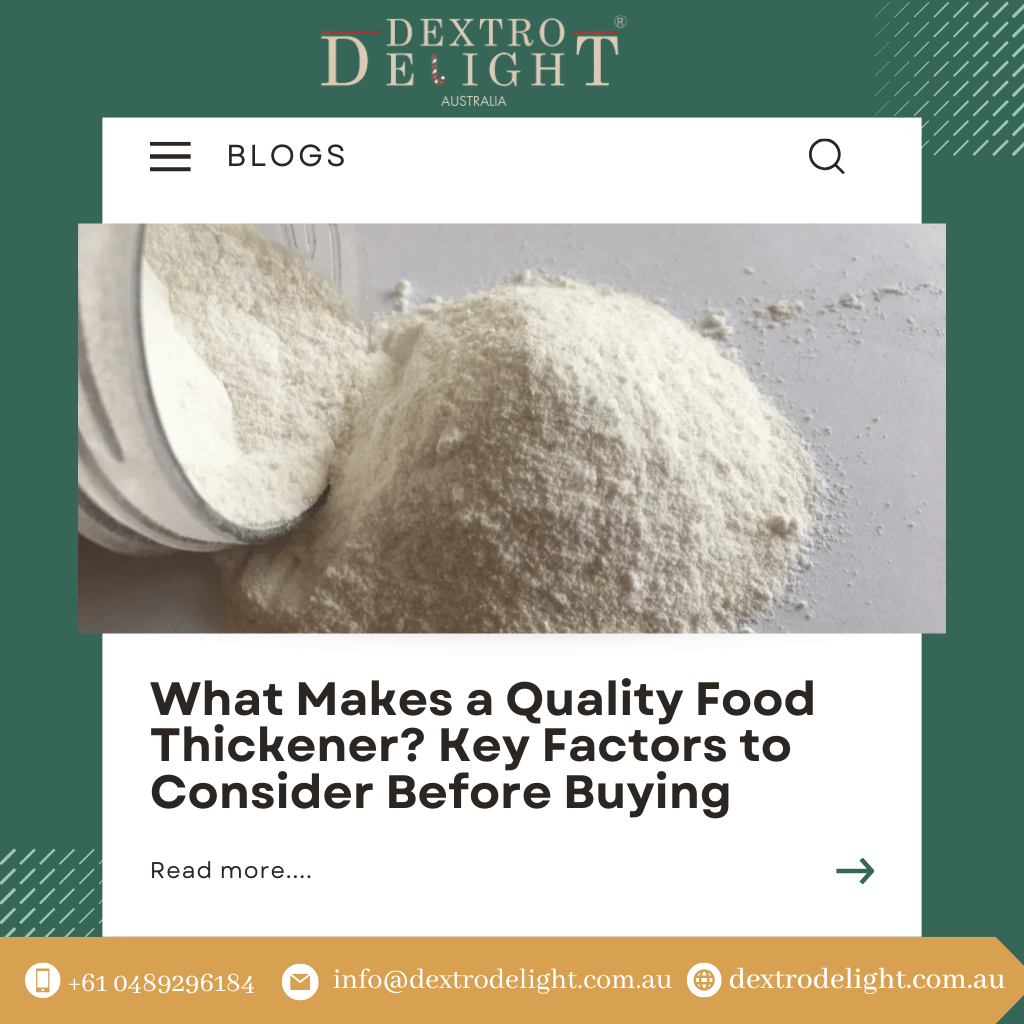
What Makes a Quality Food Thickener? Key Factors to Consider Before Buying
For food manufacturers, chefs, and product developers, it will be extremely important for a thickener to provide the right feel to consumers. The wrong selection will affect the texture, stability, mouthfeel, and shelf life.
There are so many food thickeners on the market; so it gets tough to identify the best food thickeners needed for a certain application. This guide will explain all the steps and criteria relevant to each method of selection; it is data-based and follows industry norms.
1. Understand the Role of a Food Thickener
Essentially, food thickeners increase the viscosity of liquids and do not affect any other properties.
Different applications may require thickening: sauce, soup, dairy, baked goods, and confectionery.
The thickener you select will influence:
- Texture and mouthfeel: Do you want a creamy custard, glossy sauce, or gelled dessert?
- Stability: Do you want the mixture to separate within a day?
- Appearance: Transparent, opaque, or glossy finish, depending on product goal.
- Compatibility with processing: Can it handle the different heat or freezing temperatures, extreme pH, and mechanical stress?
For instance, xanthan gum is selected for acid dressings since it maintains viscosity at a broad pH range. By contrast, pectin gels at very narrow pH ranges are used in jams and fruit preserves.
2. Match the Thickener to the Product Type
Different thickeners excel at different applications. Use of the wrong one will ruin the product’s texture and its stability.
Examples:
| Product Type | Recommended Thickeners | Why They Work Well |
|---|---|---|
| Dairy-based desserts | Gelatin, carrageenan | Creamy texture, smooth set |
| Fruit-based fillings | Pectin, arrowroot | Works well with acidic pH |
| Sauces & gravies | Cornstarch, modified starches | Glossy finish, easy to use |
| Gluten-free baking | Xanthan gum, guar gum | Replaces gluten structure |
| Vegan jellies | Agar-agar | Plant-based, heat-stable |
The best food thickeners are matched with the composition and processing needs of your product. For instance, potato starch tends to give a high glossy appearance to soups, whereas tapioca starch may guarantee stability during freezing and thawing.
3. Assess Processing Conditions
A thickening agent should remain stable while undergoing the manufacturing process. Consider these important aspects:
- Temperature resistance: Agar-agar normally sets at higher temperatures, while gelatin melts at body temperature.
- Shear stability: These properties are necessary for products that are subject to high-speed mixing or pumping.
- Freeze-thaw stability: Compared to cornstarch, which can turn watery upon thawing, tapioca starch works better in frozen desserts.
- pH sensitivity: Pectin needs an acidic environment, whereas xanthan can tolerate a broad range of pH variations.
Selecting an incompatible thickener for your process may cause phase separation, graininess, or loss of viscosity over time.
4. Evaluate Viscosity and Texture Requirements
Viscosity basically defines how thick or thin a product is. A quality food thickener should give you the texture you desire time after time.
For instance:
–Light viscosity: For beverages and broths (e.g., guar gum in smoothies)
–Medium viscosity: For sauces and gravies (e.g., cornstarch, arrowroot)
–High viscosity or gel: For desserts and moulded products (e.g., gelatin and agar-agar)
Trial batches should determine how well your thickener will work with your recipe and processing method.
5. Shelf Life and Stability Consideration
One thing that is generally ignored in buying a thickener is its effects on the shelf life of the product. Therefore, an excellent thickener will prevent any water separation (syneresis) during storage and maintain the texture of the product.
Some examples are Carrageenan in chocolate milk, which keeps the cocoa particles in suspension and stops them from settling out. Conversely, xanthan gum keeps salad dressings stable for months without shaking.
6. Check Allergen and Dietary Compliance
The consumer and dietary requirements should be taken care of.
Some common considerations are:
- Gluten-free – Tapioca starch, arrowroot, guar gum, xanthan gum
- Vegan/vegetarian – Agar, pectin (not gelatin)
- Clean label – Natural hydrocolloids like guar gum and pectin over chemically modified starches
This broadens your clientele base and allows you to stay in compliance with food labelling laws.
7. Compare Cost vs. Performance
Price often becomes a major factor in the decision-making process. Some thickeners might seem more costly per kilogram, but practically require extremely small quantities, less than 1% to get good results. Others are inexpensive with the purchase price but require higher usage levels.
The key is striking a fine balance between cost and performance with respect to selecting the best food thickeners for longer-term use.
8. Quality Indicators to Look for in a Supplier
A trustworthy supplier will provide:
- Technical Data Sheets (TDS) and Certificates of Analysis (CoA)
- Consistency from batch to batch
- Proper and adequate labelling, including origin and method of processing
- Support for trials and application testing
This ensures that the purchase of a thickener will produce an even effect in every batch.
Conclusion
Considering the thickener’s viscosity, stability, pH tolerance, and compatibility with its processing methods can aid in choosing the best food thickeners for various applications. A correct choice will ensure that the end product will meet consumer expectations and production requirements in texture, stability, and shelf life.
Dextro Delight offers performance-tested and quality thickeners suitable for all types of food manufacturing applications.
Contact our experts through our website and let’s discuss your next formulation.
